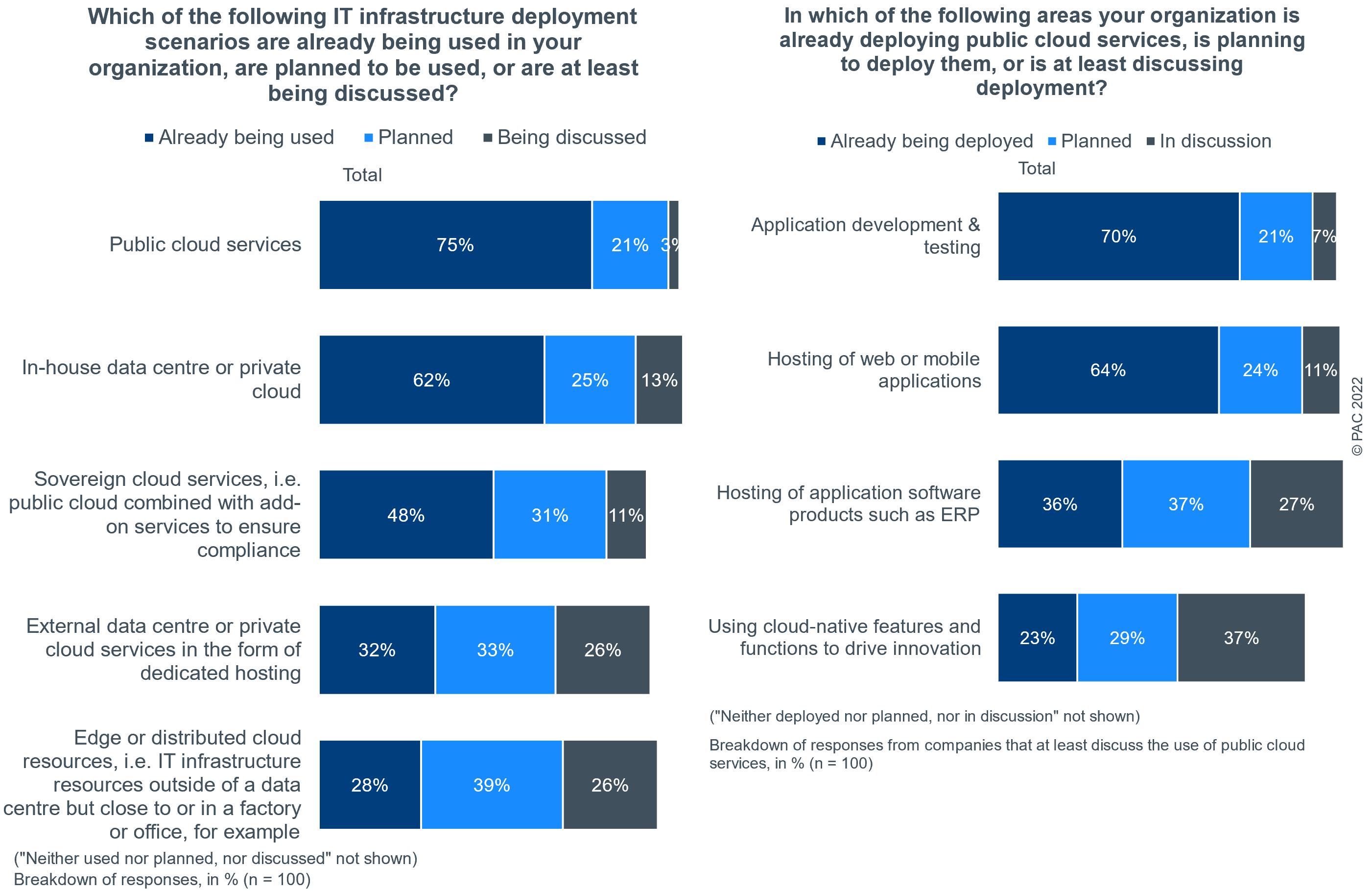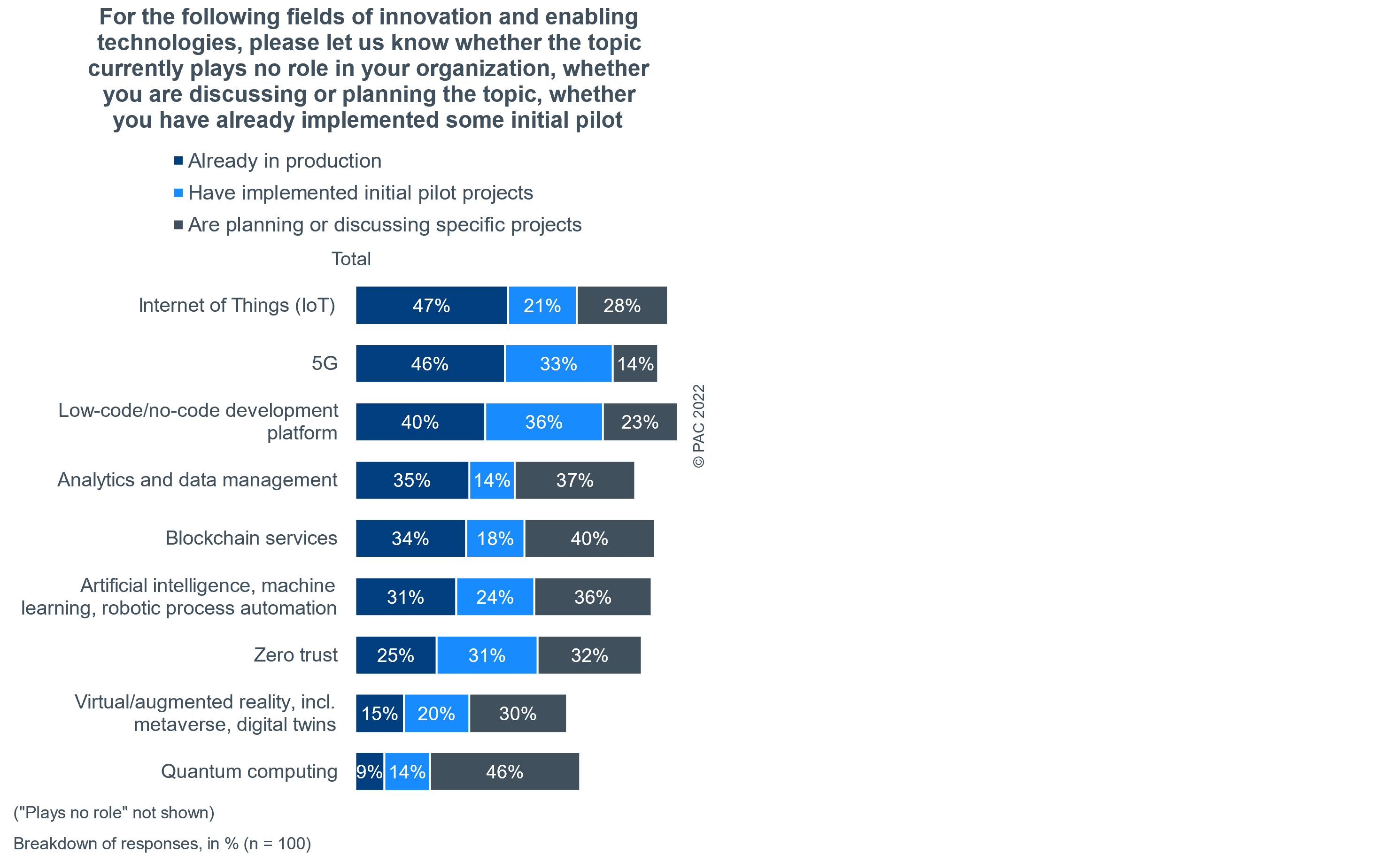The enabling technologies behind digital innovation - II
The role of the cloud
Organizations from all sectors are gearing up for their digital future. And they are doing so by investing massively in data-centric and eco-system-oriented platforms. And most of these developments are taking place in a public cloud. Among the surveyed organizations, no more than 25% does not yet use public cloud services. And within this group of procrastinators, almost 85% are planning to use public cloud services.
Public Cloud Use Cases
With 70% confirmation rate, application development & testing is the by far most established use case for public cloud services, followed by web or mobile applications hosting.
More than one third already hosts application software products such as ERP on public cloud platforms. And the massively increasing importance of public clouds for complex application hosting is confirmed by another 37% planning, and 27% at least discussing it – meaning that no participant excludes this scenario.
And the public cloud is not only considered as software development and hosting platform, but increasingly as launching ramp for innovation. The established usage of cloud-native features and functions to drive innovation was confirmed by 24% of the participants, 29% have concrete plans, and another 37% are at least discussing the use of cloud-native features for their innovation strategies.
Diverse range of deployment models
But public cloud is not necessarily the best solution for all workloads; data-heavy AI applications, e.g., might be operated cheaper, and with lower latency, on-premises. Even more, there is an increasing fear of untransparent and/or excessive costs due to complex cloud pricing. Accordingly, the concept and basic technologies of cloud computing have been extended to a diverse range of deployment models, including customer data center and edge locations as well as third-party locations:
In most cases, public cloud services did not fully replace traditional IT infrastructures; more than 60% of the survey participants still own an inhouse data center or private cloud, almost one third uses externally hosted, but dedicated resources.
A surprisingly huge share of organizations, 48%, indicated to already use “sovereign cloud solutions”, another 42% are planning or discussing to do so. These numbers are in accordance with the great importance of public clouds for digital innovation on the one hand, and the fact that 89% of the survey participants consider “appropriate solutions for data sovereignty” as a very or somewhat important aspect regarding a service partner for digital innovation, on the other hand. But as narrowly defined “sovereignty solutions”, i.e. public cloud combined with add-on services to ensure compliance”, that usually come with a surcharge, are not necessarily relevant for all clients and all use cases to the same degree, the willingness to invest usually depends on regulatory requirements and/or the sensitivity of workloads. It can thus be assumed that not all respondents referred to a strictly narrow definition of “sovereign cloud”, but to one of the various alternative cloud deployment models on the market, ranging from additionally secured hyperscaler solutions to public cloud services from European vendors.
Edge or distributed cloud resources, i.e. IT infrastructure resources outside of a data center but close to or in a factory or office, for example, are used by 28% of the surveyed organizations; a whole further two thirds are planning or at least discussing it. Distributed models such as edge computing offer advantages in terms of latency and availability. In case of failures, usually only a few local edge servers are affected. The latency times in a cloud are often too long for the operation of real-time systems, which makes edge systems the better choice here.
PAC doesn’t expect the trend towards cloud migration to stop soon; not least because cloud platforms are nurturing ground and important basis for a great variety of further technologies that support digital innovation.
Further digital innovation-enabling technologies
The Internet of Things (IoT) brings digital innovation to the production processes and the end products of organizations in many different industries. By adding local intelligence to products and machines and by providing holistic platforms for data aggregation and analysis, organizations are able to transform their business models and provide new high-value services to their customers. IoT use cases are manifold, ranging from connected vehicles, smart home & buildings and smart energy to digital government & smart cities, digital health, and digital factory.
5G marks a new era for the Internet of Things and presents a significant opportunity for organizations to improve their operations. 5G is an innovative radio technology that provides an extended frequency spectrum.
In the consumer market, it is positioned around faster connectivity and more bandwidth to provide consumer-based social, media, and gaming services. In the professional area, 5G networks provide, in combination with technologies such as IoT or artificial intelligence, new technologies and services in a broad range of industries, from manufacturing to automotive, logistics, smart cities, utilities, or healthcare, that are not feasible in traditional Wi-Fi and wired networks.
Better use of data, improved customer experience and more resilient and transparent supply chains were among the most important drivers of digital innovation. To achieve this, a combination of internet-of-things (IoT), cloud and edge computing, artificial intelligence and analytics, etc., are required to drive the levels of data insight sought.
The level of digitization needed for a wide range of facilities is asserting pressure on organisations from a connectivity perspective. 5G can thus be considered as a backbone for a variety of use cases by providing consistent, fast, and scalable data connectivity services, and is expected to have a significant impact on direct and indirect customer service functions, as well as on supply chain, logistics and distribution operating processes.
Depending on the requirements, a 5G network can be self-operated as a separate campus network, used via the network of a public mobile network operator, or in hybrid scenarios.
Typical use cases for 5G are as manifold as for IoT. In the industrial IoT, e.g., cyber-physical production systems rely on a stable and high-performance digital infrastructure that meets high communication requirements so that people, machines, products, and all kinds of other devices can communicate flexibly, securely, and reliably. Just as autonomously operating fork lifters and other autonomous vehicles in intralogistics centers. Or doctors, patients, and medical equipment in digital health scenarios. In contrast to Wi-Fi, many more users can be provided with information at the same time, which is beneficial for smart sports, entertainment, events, and media. Etc.
Low-code/no-code development platforms are software development environments that allow to “drag and drop” existing application components, connect them, and thus create applications without the need for comprehensive coding. Such platforms thus provide businesses the ability to create software quicker and at lower costs, and not least to meet the challenges of the omnipresent skill shortage in IT.
Analytics and data management are directly addressing the most-stated goal of digital innovation in our survey, better use of data; it is at the heart of any digital transformation, and at the same time an important basis for a range of another important technologies, artificial intelligence and machine learning. AI is the combined use of algorithms, knowledge bases (big data sets), and neural networks/ deep learning techniques to mimic and complement human abilities in a variety of domains, including perception and understanding, reasoning and problem solving, learning and training, interaction with surroundings and people, etc. AI techniques can enhance and augment multiple solutions, such as RPA (robotic process automation) and RDA (robotic desktop automation), expert systems (designed to perform specific tasks), chatbots, assistants (helping consumers and employees in various tasks) and autonomous systems (such as industrial robots and cars).
The importance of cyber security remains consistently high. The idea behind Zero Trust is simple: organizations should not automatically trust devices or users inside or outside their perimeters but should instead verify every access request to their systems before granting it. It is a way of thinking rather than a technical concept, and comprises a comprehensive consideration of an organization’s environment, including identities, applications, networks, data, and devices. Zero Trust approaches are becoming more popular, but the final stage has rarely been achieved so far.
Blockchain technology is another investment topic for many industries. At its core, a blockchain is a distributed database. The broad distribution of information is the most important feature of blockchain solutions, as it promises maximum transparency, immutability and protection against manipulation, and security. So-called smart contracts can ease collaboration between partners and can be used to create workflows and business processes automation. Payment services and traceability were the most-mentioned use cases of the survey participants, but there were many others.
Augmented and virtual reality have seen a significant rise in popularity in the past decade. While virtual reality (VR) refers to a digital image of reality created on a computer, augmented reality (AR) is the interaction of digital and analog life. A digital twin is considered as a virtual representation of a physical product, space (e.g., building, factory), or process (e.g., production) that can be used for simulations before their real-life twins are touched. The ultimate goal of the metaverse is to create a seamless world without interruption, similar to the real world. It includes elements of both AR and VR. While the B2C metaverse is very much focused on consumption, the enterprise metaverse addresses virtual collaboration, immersive learning, and virtual collaborative design, as well as AI training.
One of the reasons for the excitement around quantum computers is the way they can scale for complex tasks like modelling. Real quantum computing is still a long way off, but the development of these computers is a process of evolution, and annealer technology is here already and can shift tasks which are currently done as batches such as scheduling and fleet movements into real time. The survey participants mentioned various interesting use cases, grouped around route optimization, real-time matching of supply and demand, forecasting, and simulation.
Analytics and data management, IoT, AI/ML, blockchain, AR/VR and quantum computing will each be covered in a dedicated section.


0 thoughts on "The enabling technologies behind digital innovation – II"